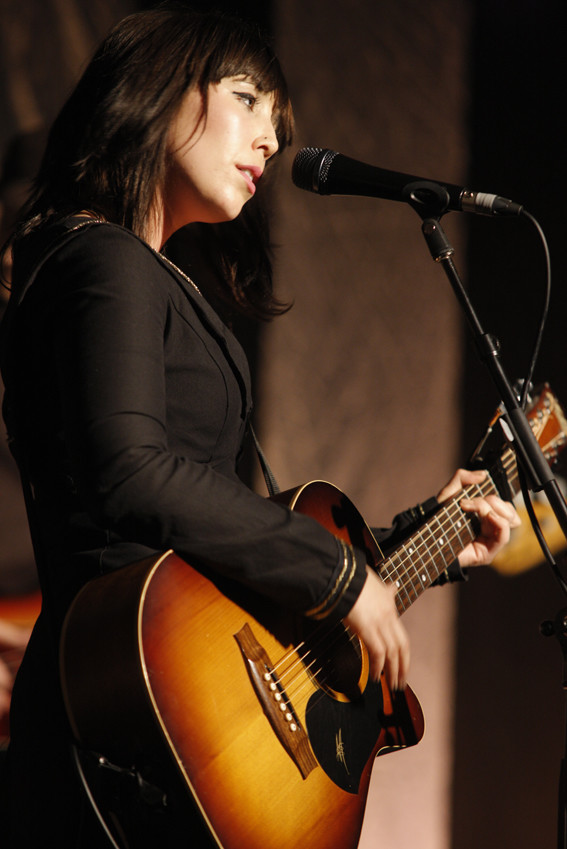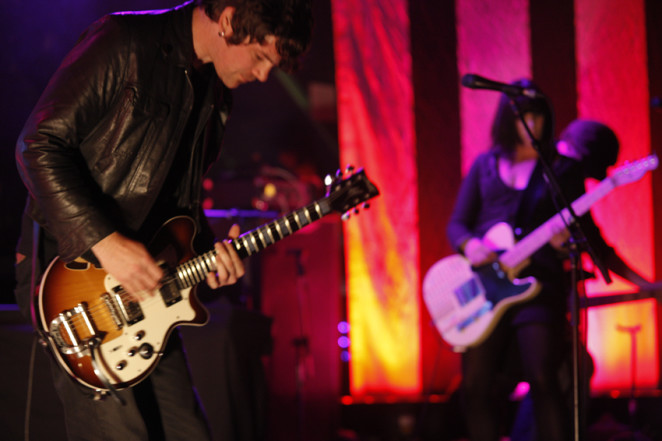LITTLE BIRDY – Spread Some Confetti
July 1, 2009 | Author: Peter Hodgson. Pics by Marty Williams
 Recorded the old fashioned way – with a group of talented musicians in a room playing carefully crafted songs – Confetti is a breath of fresh air in a musical climate which is all too often stifled by the kind of over-tweaking and tweezing that’s so easy to get carried away with in the modern recording environment.
Recorded the old fashioned way – with a group of talented musicians in a room playing carefully crafted songs – Confetti is a breath of fresh air in a musical climate which is all too often stifled by the kind of over-tweaking and tweezing that’s so easy to get carried away with in the modern recording environment.
The album was recorded in Little Birdy’s new home of Melbourne, and the move influenced the project in subtle ways. “We had quite a few different people come in,” drummer Matt Chequer said. “We had a horn section, a string section, some gospel singers. So all those things added their little sound to it. I’m not sure if they were particularly Melbourne, but just having so many more people, I suppose. Steven Schram (producer) knew a lot of players around town so he was able to hook us up with different ones for different purposes. The horn section was particularly interesting because we’d written the horn line and we wanted them to play pretty much what we’d come up with on the keyboard for our demos. They didn’t read any sheet music or anything, they just came in and said ‘okay, just hum what you want us to play.’ We thought that was such a great approach. They were completely professional. It really worked for that particular thing.”
As for influencing the album sound, Chequer said the move inspired everyone to different degrees. “It’s hard to put a finger on it, but particularly for Katy (Steele, vocals/guitar) it was a big change. She really grew up in a short space of time and was really influenced by a lot of different musicians around, just going out and meeting people.”
A theme that runs subtly through the background of Confetti is the influence of Motown – its song craft, its production methods and its overall vibe. Chequer explains, “As a band we’ve always listened to those old, timeless records that, in twenty years or thirty years time won’t be dated. Most of the songs Katy had written were able to stand up on their own. She wrote maybe half of the album when she was asked to support Paul Kelly on tour. She wanted a bunch of new songs. She didn’t want to play old Little Birdy songs on tour. In production it was about honouring that and letting the songs and vocals breathe.”
“Every song is the four of us in the room playing together,” Chequer continues. “There are a few overdubs here and there but most of it was tracked straight onto tape then a few bits and pieces were added where we didn’t have enough musicians on hand to play everything. One song in particular, ‘Into My Arms,’ the whole thing is one take, with Katy singing and playing the piano, and the three of us in the same room to really capture that organic feel. We tried to pick up what the Motown guys did – back in the days when you didn’t have overdubs, you just got in there and bashed it out and put it on tape. On Hollywood, our last album, it was all layered and things were done on Pro Tools and chopped up. You can really hear that, and that’s the kind of album we were making. For this one we wanted to go back to being a real band again, I suppose. Even where I do a tambourine overdub, when though it’s not live you can still here when I’m just standing there and it’s rattling while I’m waiting to play it again. Tiny little things like that. There are a couple of songs where you can hear Katy whispering tiny things. Just keeping those in there gives it a more personal approach.”
“Steve, the engineer, isn’t a technical guy,” Chequer says. “He learned from his ear and from other producers. We would get a sound from an amp and he’d say “I can go with that” or he’d suggest changes, then he’d stick a mic in front of it wherever it sounded good. It was really simple. Just getting the tones right before you stick a mic in front of it. A lot of people, and I suffered from this in the past, think you can fix it in mixing, which is not the case because then you just take all the soul out of the sound.”
With several of the songs starting life as solo material performed by Steele, Little Birdy took a lot of time finding the right groove for each track. Chequer cites ‘Brother,’ which includes guest vocals from Paul Kelly, as an example. “That was a lot of Steve, getting that snare sound and those drum sounds and stuff,” he says. “When we demoed that song we didn’t have drums on it, so that was mainly him, that train shuffle. The handclaps were a big part of that. We just got a bunch of friends in for the handclaps. Someone said to me it sounded a bit like there’s a whip cracking with those handclaps, and … I think that was a bit of a mistake. I think what happened was we had a speaker playing the song back and we couldn’t quite hear it properly so I turned it up, and I think that’s where the weird sound comes from. I think Steve blames me for that one, but it works well!”
 Single ‘Summerize’ started out as a country song written for the Paul Kelly tour. “Katy was playing it pretty much exactly as it is but with a country swing,” Chequer says. “We always really liked that song. It was one of my favourites when I used to go watch her solo. I was looking forward to doing it that way, then we got into demoing and we just couldn’t find the right groove for it to sound right as a country song. I was listening to Sly & The Family Stone and I heard the backbeat to ‘Dance To The Music’ and thought “That might work!”
Single ‘Summerize’ started out as a country song written for the Paul Kelly tour. “Katy was playing it pretty much exactly as it is but with a country swing,” Chequer says. “We always really liked that song. It was one of my favourites when I used to go watch her solo. I was looking forward to doing it that way, then we got into demoing and we just couldn’t find the right groove for it to sound right as a country song. I was listening to Sly & The Family Stone and I heard the backbeat to ‘Dance To The Music’ and thought “That might work!”
Confetti concludes with a hidden track, buried at the end of the album – a trick that was popular in the 90s but hasn’t really been used much since. “I think the last hidden track I heard was on Nirvana’s ‘In Utero’,” Chequer says. “I really wanted that song to be on the album but it didn’t really fit in with the other songs. And nobody really does that much these days – with everything on iTunes and mp3 it doesn’t really make sense. It’s a bit of a shame, and you’ve got to move with the times I suppose, but now CDs are becoming what records were. But what are we gonna do, hey? I hope there’s always some physical element, whether it’s a CD or whatever comes next, but there’s nothing better than having an album in your hands, reading the lyrics, reading the thank-yous, where it was mastered and all these little things.”


